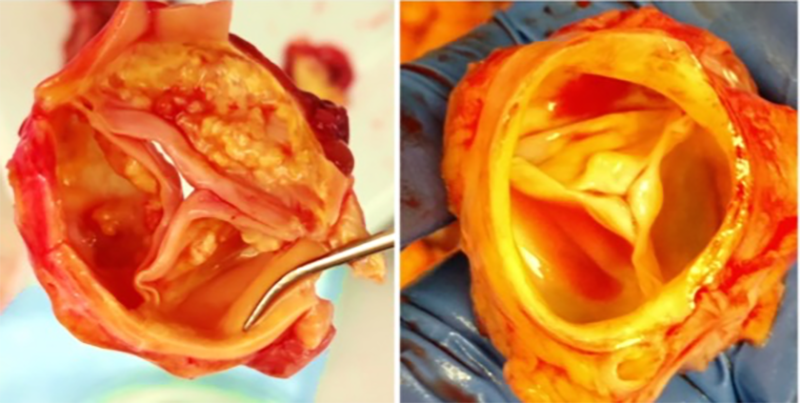By Kat Procyk

A calcified valve acquired by the St. Hilaire lab for their bio bank.
Cardiovascular disease is the leading cause of death worldwide, with aortic valve complications accounting for about 25% of these fatalities. The primary issue is calcium build-up in a valve leaflet, which leads to narrowing—called aortic stenosis—that impedes blood flow, significantly increasing the heart’s workload.
Treatment for a calcified valve isn’t available until the calcification becomes severe enough to require surgical replacement. However, a team of researchers and surgeons at the University of Pittsburgh School of Medicine is in the process of securing patents for an idea to develop potential therapies that can halt, prevent or reverse aortic valve or bioprosthetic valve calcification by intercepting the relationship between the two proteins, telomerase reverse transcriptase (TERT) and the protein STAT5.
But first, the research team needed to understand why a healthy cell would calcify. Like other vascular cells in the body, valve cells can undergo osteogenic reprogramming, shifting from a healthy state into one that mimics bone-forming cells called osteoblasts.
“Scientists once thought calcification was a passive, degenerative process, but the past few decades of research now show it's an active cell process in response to mechanical stress, malformations and inflammation over years,” said Cynthia St. Hilaire, associate professor of medicine, Division of Cardiology, School of Medicine. “Our lab is exploring the stresses and cellular changes required for a cell to reprogram from its healthy state to what we call an osteogenic state—a cell capable of forming a calcified matrix the way bone does.”
St. Hilaire’s early interest in valve research led her lab to build a biobank for human arterial and valvular tissues with the help of cardiothoracic surgeons at UPMC’s Heart and Vascular Institute. When her lab began studying valve calcification using these tissues, they initially hypothesized that it was driven by cellular senescence. This led them to focus on TERT, known for its role in preserving chromosome ends and delaying cellular senescence, which they suspected was a key driver of the process.
Instead, they found the opposite. In a study published in the journal Circulation Research in January 2025, St. Hilaire’s lab learned that even though telomere length or proliferation didn’t change, TERT expression and protein levels in calcified tissue were extremely high. They later discovered that under osteogenic or inflammatory stimulation, telomerase couples with chromatic remodeling factors and STAT5, which regulates cellular processes.
“What this complex does is open the chromatin and allow STAT5 to bind to the RUNX2 gene promoter, which is a master regulator of osteogenic genes’ transcription,” explained St. Hilaire. “This is the initial switch that allows these aortic valve cells to reprogram into a pro-calcifying cell and, by finding this pathway, we have a new druggable target.”
Ibrahim Sultan, professor and executive vice chair, Department of Cardiothoracic Surgery, School of Medicine, was interested in collaborating with St. Hilaire because of the sheer volume of calcified aortic disease cases he encounters daily.
“Understanding TERT’s noncanonical activity was not only intriguing, but potentially impactful for improving patient care,” said Sultan, who is also the co-director for the Heart and Vascular Institute. “Collaboration between research scientists and surgeons like this is essential for accelerated medical innovation as it leads to better, less invasive outcomes for patients.”
They have now developed a new tool using SplitFAST technology to visualize when TERT and STAT5 are coming together and going apart, enabling researchers to screen for drug compounds or develop new ones that inhibit the interaction between TERT and STAT5. The research could also improve the lifespan of bioprosthetic valves by preventing calcification.
Pitt’s Innovation Institute provided guidance on protecting the intellectual property behind these discoveries and is helping to navigate the patent process as the research team continues to secure more.
The research team plans to either license the idea or start a company to further develop and commercialize its findings.
